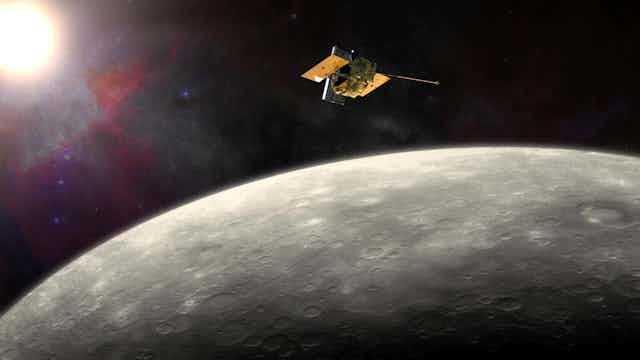Very soon, probably on 30 April, a half-tonne spacecraft will plough into the surface of Mercury, the closest planet to the sun, at about 4km/s or nearly 9,000mph. The spacecraft is NASA’s MESSENGER (“MErcury Surface, Space ENvironment, GEochemistry, and Ranging”), which became the first spacecraft ever to orbit Mercury in March 2011.
Launched in 2004 and operated by Johns Hopkins University’s Applied Physics Laboratory, MESSENGER’s final act in its ten-year mission will be to “de-orbit” (the term NASA prefers to “crash”) into the planet. This will create a 15m wide crater, which will be studied when Europe’s BepiColombo mission reaches Mercury in 2024. But that’s not the reason for disposing of MESSENGER like this – the spacecraft has simply run out of fuel and the sun’s influence and slight asymmetries in Mercury’s gravity field are dragging MESSENGER downwards.
During MESSENGER’s first three years at Mercury, the mission controllers kept its orbital low point between 200-450km above the planet’s surface. In 2014 they allowed it to dip below 100km, sometimes coming as low as 30km before using precious hydrazine fuel to raise its orbit higher, but in its final six weeks its orbital low point has been between 5km-35km. Without fuel to push it higher, mission controllers on the last three occasions have ingeniously raised MESSENGER’s orbit by venting pressurised helium – now that too has been exhausted.

First rock from the sun
But what a mission it’s been. The only previous mission to Mercury was Mariner 10, which performed three fly-bys in 1974-5 that provided only an incomplete view. MESSENGER has revealed the entire planet in detail, especially the northern hemisphere to which MESSENGER was brought closest by its deliberately eccentric orbit before soaring upwards to escape the 400°C temperatures at the surface.
What’s now apparent is that Mercury is a misfit planet that seems not to belong where we find it. It is dense even for a rocky planet, revealing an iron-rich core that occupies more than 80% of the planet. The outer part of the core must still be molten, because this is where Mercury’s magnetic field is generated – a characteristic shared with the Earth, unlike Venus, Mars or the Moon.

Volatile-rich planet
Before MESSENGER’s visit, Mercury’s thin rocky shell over an anomalously large core was explained as a consequence of growth too near the sun for much rock to condense, or the result of a catastrophic collision that stripped away most of the planet’s original rocky component. Data from MESSENGER has discredited both options, revealing that Mercury is rich in volatile substances that should have been depleted even more strongly than the common rocky material during the heat and violence of a collision, or else never even have been there in the first place.

Examples include sulfur, which makes up 2-5% of the surface, and light metals such as potassium and sodium. Most of the terrain consists of vast ancient lava fields (like basalt on Earth, but richer in magnesium and poorer in iron). These are ancient, more than three billion years old, but MESSENGER’s high-resolution images also revealed volcanic vents punching through the lava and through the floors of impact craters, which have clearly been sites of more recent explosive volcanic eruptions. An explosive eruption has to be driven by expanding gas, escaping from the planet’s interior – more proof of Mercury’s richness in volatiles.

And then there are the “hollows”, a previously unknown landscape feature. These are steep-sided, flat-bottomed depressions where the top 10m or so of Mercury’s surface has simply vanished. With no atmosphere, there are no winds on Mercury to erode it, nor are there any signs of collapse into underground cavities, leaving us to conclude that something in the ground has been turned to vapour and lost to space.
What this stuff is and whether it turns from solid to vapour through heating (a process called sublimation) or because chemical bonds are broken by radiation of some sort, we don’t know. It’s another piece in the jigsaw puzzle that must one day be fitted together if we are to understand where and how the sun’s smallest and closest planet formed.

